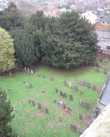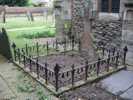For this church:    |
Bingham St Mary and All SaintsChurchyard
In the Middle Ages the churchyard did not have exactly the same boundaries that it has now. At some point, for instance, it was extended on the south side across the road, leaving just a narrow path joining Church Street and East Street. The boundary wall with its railings on this side dates from the 18th Century. Half an acre was added on the north side in 1840. Most of the headstones date from the 18th and 19th Centuries, with a few from the 17th Century (the oldest dates from 1681). The majority of them are made of Swithland slate and some of Welsh slate. Consequently the inscriptions on them are still very clear. Several are listed. The churchyard was closed for burials in the late 19th Century and in theory no new graves have been dug since then, though further burials in family plots continued for some time. Some Significant Graves
|
HE SAID COME  R.I.P.  ROBERT MILES Died October 25 1883 Aged 84 Rector of this Parish for 38 years  A SERVANT OF JESUS CHRIST  MARY MILES Died November 15 1887 Aged ....  THEY WERE LOVELY IN THEIR LIVES |
Note: The date of Robert Miles’ death appears on the stone more like October 15. It is however eroded and the date is very clearly October 25 on the Miles Memorial window, and indeed in contemporary press reports of his death. As regards Mary only the ‘November’ of the date can be read, but this date is again clear on the window.
The quotation at the bottom is severely eroded and only the beginning and end of the two longer lines is visible. However this particular quotation (from 2 Samuel 1.23) is not uncommon on Victorian memorials and seems certain. The first part of it also appears on one of the windows which itself may date from Robert Miles’ time.
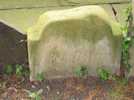 Headstone
with Headstone
withdate 1681 |
Thomas Hean |
17th Century Headstones
One small headstone carries the date 1681, but no other inscription is readable on it. This may well be the oldest headstone in the churchyard.
The oldest stone with a legible name reads:
Here |
The stone for Thomas Hean (presumably Mary’s husband) is right next to hers and is of the same style. The date of his death is now below ground level and cannot be read without excavation, but according to the listing is the year 1700.
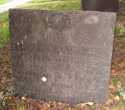 One
of the ‘Belvoir One
of the ‘BelvoirAngel’ headstones (This is dated 1704) |
Belvoir Angels
Three early gravestones in the churchyard are decorated with the ‘Belvoir Angel’ motif. This is a particular ‘naïve’ design of an almost childish moon-like face flanked by triangular wings, which is unique to churchyards in this area.
Artistic and Verse Inscriptions
The inscriptions on the slate headstones are remarkably well preseved, and some of them carry designs and verses typical of their times. A particularly beloved one is on a stone near the main door of the church which reads:
BENEATH THIS STONE LIES |
(Thomas Hart, who is commemorated on this stone, is known to have had three wives. The first wife is said to have died after drinking two bottles of communion wine! Presumably, as he was parish clerk, looking after the communion wine would have been one of Thomas’ responsibilities.)
The stone next to this one, to the three children of Samuel and Mary Wright, has a particularly fine decorative carving of Bingham on the Day of Resurrection.
When Throsby visited the church in the late 18th Century he wrote down several of the verses from the headstones commenting:
I don’t frequently copy hackney’d verses from grave-stones; but having no inclination to climb up into the steeple to see the bells, I transcribed these, which are beyond the ordinary class of inscriptions.
Other Features
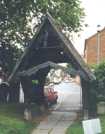 The
lychgate The
lychgatebefore restoration |
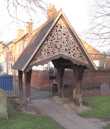 The
lychgate now The
lychgate now |
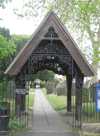 The
lychgate The
lychgatefrom outside |
 The
lychgate The
lychgatephotographed in 1917 |
Lychgate
The lychgate was erected in 1881 during the time of Robert Miles. It was designed by his son Frank who was an architect and artist. On the western side it is decorated with wrought iron work which was designed by Mary Miles (wife of Robert). There are carved cedar panels on the eastern side. Over the entrance is the inscription:
THROUGH THE GRAVE & GATE OF DEATH TO OUR JOYFUL RESURRECTION |
This inscription was carved by Robert Miles personally.
By the turn of the last century the lychgate had developed a distinct list, and the cedar panels had suffered severe depredations from weather and vandals. It was restored as a millennium project in the year 2000 by the Friends of Bingham Parish Church, working with the architect Allan Joyce.
Plants
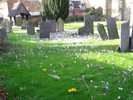 Crocuses
in the Crocuses
in thechurchyard in spring |
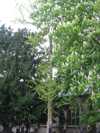 The
ginkgo tree The
ginkgo tree |
The churchyard is noted for its spring bulbs. The display of crocuses can be particularly spectactular.
One other curious feature of the churchyard is the ginkgo tree. The Ginkgo biloba (or maidenhair tree) is a rare survival of an ancient family of trees, and the tree in Bingham churchyard is one of the few mature specimens in the English midlands. It was planted here by Frank Miles, son of Robert Miles.
Garden of Remembrance
In 1989 an area in the north part of the churchyard, next to the church north door, was cleared of headstones, delineated by slabs in the ground, and designated a Garden of Remembrance for the interment of cremated remains. (Cremated remains had been buried in the churyard before this, but unfortunately no record was kept of where they were.)
Churchyard Recording Project
In recent years it had been a concern that there was no record of those buried in the churchyard. In 2005-06 a major survey was undertaken by the Bingham Heritage Trails Association, and a list was made of all the memorials in the churchyard (and also inside the church) with as much as could be distinguished of the inscriptions. This list is now available as a searchable database.


